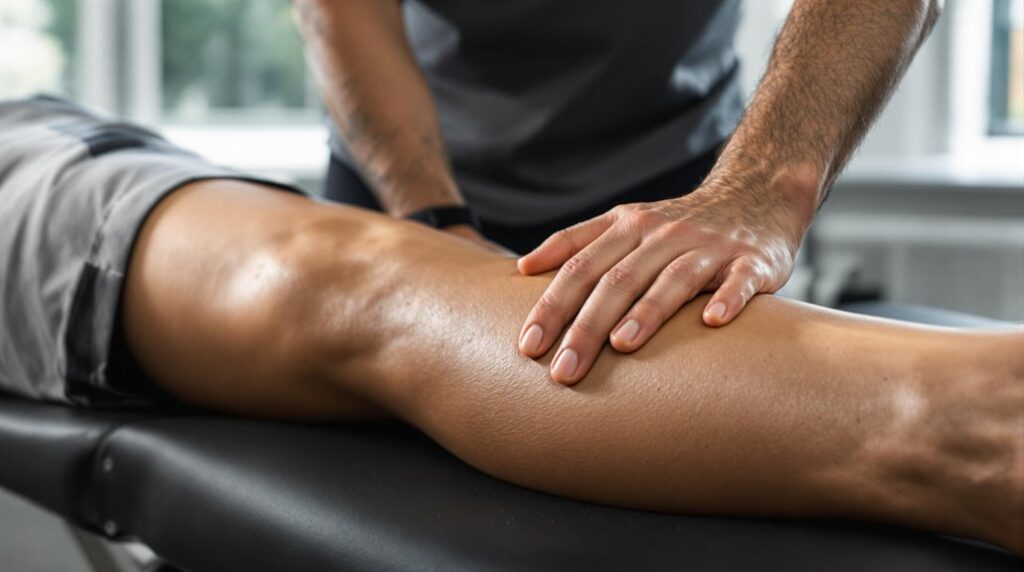To prevent athletic injuries through massage, you'll need to implement specific techniques before and after training. Pre-event massage should focus on quick, stimulating strokes to increase blood flow, while post-training recovery requires gentle effleurage followed by deeper kneading. Target common problem areas like the lower back, hamstrings, and rotator cuff muscles using foam rollers, massage guns, and trigger point balls. Regular self-massage routines can reduce injury risk by up to 30% and enhance your overall athletic performance. Exploring these techniques in detail will reveal their full potential for injury prevention.
Understanding Sports Massage and Its Benefits
While athletes often focus primarily on training and nutrition, sports massage plays an essential role in maintaining peak performance and preventing injuries. You'll find that sports massage promotes circulation, reduces muscle tension, and helps identify potential problem areas before they become serious injuries. Through targeted manipulation of soft tissues, you're able to increase flexibility, decrease recovery time, and enhance your range of motion.
Sports massage isn't just about relaxation; it's a systematic approach to maintaining your body's mechanical function. You'll experience improved lymphatic drainage, which helps remove metabolic waste and reduce inflammation. The technique also breaks down adhesions and scar tissue that can limit your movement and performance. When you incorporate regular sports massage into your training regimen, you're investing in both injury prevention and enhanced athletic performance. Additionally, it significantly accelerates the body's healing process, allowing athletes to return to their training more efficiently.
Essential Pre-Event Massage Techniques
Pre-event massage techniques build upon the general benefits of sports massage by specifically preparing your body for upcoming athletic performance. You'll want to focus on quick, stimulating strokes that increase blood flow and warm up your muscles, typically applying these techniques 15-45 minutes before your event.
Start with effleurage, using light to moderate pressure in long, flowing strokes to warm the tissue. Then, incorporate percussion techniques like tapotement, where you'll rhythmically tap or strike the muscles to stimulate nerve endings and increase muscle tone. You can also include friction movements across your muscle fibers to enhance flexibility and reduce adhesions. Remember to keep the pressure moderate and the pace brisk, as you don't want to relax your muscles too deeply before competition. Incorporating neuromuscular techniques can further enhance the effectiveness of your pre-event massage, ensuring optimal muscle readiness.
Post-Training Recovery Massage Methods
Anyone who's completed an intense training session knows the importance of proper muscle recovery. You'll want to begin with gentle effleurage strokes to warm up the muscles, followed by deeper kneading techniques that target specific muscle groups. Focus on applying moderate pressure to areas that experienced the most stress during training, using circular motions to increase blood flow and reduce lactic acid buildup.
To maximize recovery benefits, you should incorporate cross-fiber friction techniques on any adhesions you find, spending extra time on common problem areas like the IT band and quadriceps. Finish your recovery massage with compression strokes that help flush metabolic waste from the muscles, and don't forget to include gentle stretching movements to maintain tissue flexibility. For best results, perform these techniques within two hours after training. Additionally, sports massage can significantly aid in performance improvement and recovery time.
Common Athletic Problem Areas and Treatment
Although every athlete faces unique physical challenges, certain muscle groups consistently require specialized attention due to their susceptibility to strain and overuse. You'll find that the lower back, hamstrings, and quadriceps are particularly vulnerable areas that need regular monitoring and treatment. The rotator cuff muscles, essential for overhead movements, often develop tension and inflammation in sports involving throwing or swimming.
To address these problem areas, you'll want to focus on specific techniques. For your lower back, try cross-fiber friction and myofascial release to target deep muscle tension. Your hamstrings will respond well to stripping techniques and trigger point therapy, while your quadriceps benefit from compression and broad strokes. Don't forget your shoulders – gentle circular movements and pin-and-stretch techniques can help maintain rotator cuff flexibility. Additionally, understanding muscle tear recovery times is essential for optimizing healing and preventing further injury.
Self-Massage Tools and Applications
Modern self-massage tools have revolutionized how athletes can maintain their muscle health between professional treatments. You'll find a variety of effective options, including foam rollers, massage guns, compression devices, and trigger point balls, each designed for specific therapeutic purposes.
When you're selecting self-massage tools, consider your sport's demands and common problem areas. Foam rollers work well for large muscle groups like quads and hamstrings, while massage guns can target deeper tissue with precision. You'll benefit most from using trigger point balls on specific areas of tension, such as your feet or shoulders. For ideal results, you should integrate these tools into your daily routine, spending 10-15 minutes before and after training sessions to maintain muscle pliability and reduce the risk of injury. Additionally, understanding ankle injury signs can help you adjust your self-massage techniques to better suit your needs.
Professional Massage Protocols for Athletes
When seeking professional massage therapy, athletes must follow specific protocols designed to enhance performance and prevent injury. You'll need to schedule sessions 48-72 hours before competition to avoid muscle soreness, and you should communicate your training schedule to your therapist for ideal timing. During high-intensity training periods, you'll benefit from twice-weekly sessions focusing on primary muscle groups.
Your massage therapist will typically begin with a thorough assessment of your biomechanics and injury history, followed by targeted work on problem areas. You'll receive a combination of deep tissue work, trigger point therapy, and myofascial release techniques, customized to your sport's demands. Post-session, you'll need to maintain proper hydration and follow specific movement protocols to maximize the therapeutic benefits.

